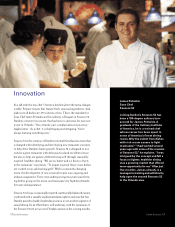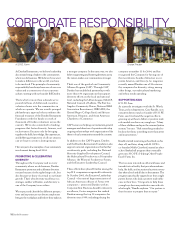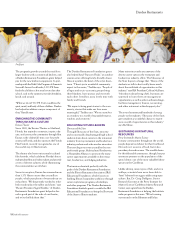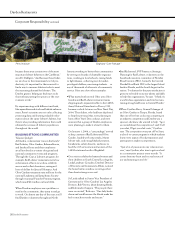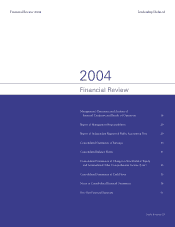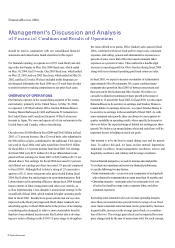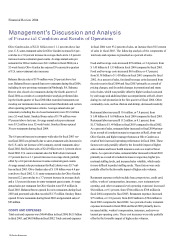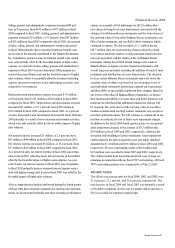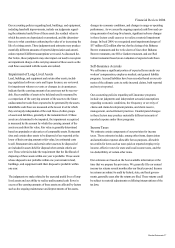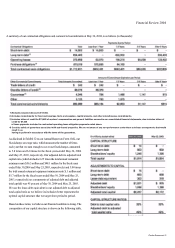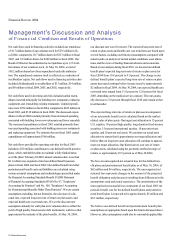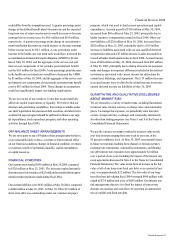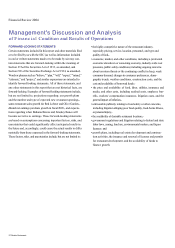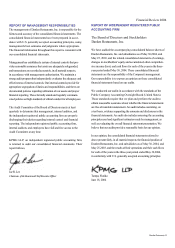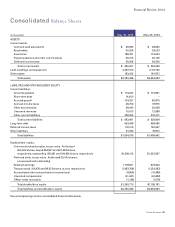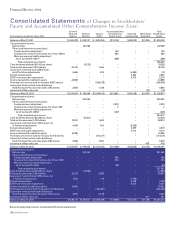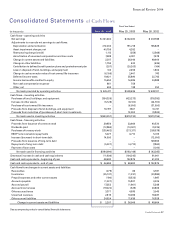Red Lobster 2004 Annual Report Download - page 27
Download and view the complete annual report
Please find page 27 of the 2004 Red Lobster annual report below. You can navigate through the pages in the report by either clicking on the pages listed below, or by using the keyword search tool below to find specific information within the annual report.
Financial Review 2004
Our accounting policies regarding land, buildings, and equipment,
including leasehold improvements, include our judgments regard-
ing the estimated useful lives of these assets, the residual values to
which the assets are depreciated or amortized, and the determina-
tion as to what constitutes enhancing the value of or increasing the
life of existing assets. These judgments and estimates may produce
materially different amounts of reported depreciation and amorti-
zation expense if different assumptions were used. As discussed fur-
ther below, these judgments may also impact our need to recognize
an impairment charge on the carrying amount of these assets as the
cash flows associated with the assets are realized.
Impairment of Long-Lived Assets
Land, buildings, and equipment and certain other assets, includ-
ing capitalized software costs and liquor licenses, are reviewed
for impairment whenever events or changes in circumstances
indicate that the carrying amount of an asset may not be recover-
able. Recoverability of assets to be held and used is measured by
a comparison of the carrying amount of the assets to the future
undiscounted net cash flows expected to be generated by the assets.
Identifiable cash flows are measured at the lowest level for which
they are largely independent of the cash flows of other groups
of assets and liabilities, generally at the restaurant level. If these
assets are determined to be impaired, the impairment recognized
is measured by the amount by which the carrying amount of the
assets exceeds their fair value. Fair value is generally determined
based on appraisals or sales prices of comparable assets. Restaurant
sites and certain other assets to be disposed of are reported at the
lower of their carrying amount or fair value, less estimated costs
to sell. Restaurant sites and certain other assets to be disposed of
are included in assets held for disposal when certain criteria are
met. These criteria include the requirement that the likelihood of
disposing of these assets within one year is probable. Those assets
whose disposal is not probable within one year remain in land,
buildings, and equipment until their disposal is probable within
one year.
The judgments we make related to the expected useful lives of long-
lived assets and our ability to realize undiscounted cash flows in
excess of the carrying amounts of these assets are affected by factors
such as the ongoing maintenance and improvements of the assets,
changes in economic conditions, and changes in usage or operating
performance. As we assess the ongoing expected cash flows and car-
rying amounts of our long-lived assets, significant adverse changes
in these factors could cause us to realize a material impairment
charge. In fiscal 2004, we recognized asset impairment charges of
$37 million ($22 million after-tax) for the closing of six Bahama
Breeze restaurants and the write-down of four other Bahama
Breeze restaurants, one Olive Garden restaurant, and one Red
Lobster restaurant based on an evaluation of expected cash flows.
Self-Insurance Accruals
We self-insure a significant portion of expected losses under our
workers' compensation, employee medical, and general liability
programs. Accrued liabilities have been recorded based on our esti-
mates of the ultimate costs to settle incurred claims, both reported
and not yet reported.
Our accounting policies regarding self-insurance programs
include our judgments and independent actuarial assumptions
regarding economic conditions, the frequency or severity of
claims and claim development patterns, and claim reserve,
management, and settlement practices. Unanticipated changes
in these factors may produce materially different amounts of
reported expense under these programs.
Income Taxes
We estimate certain components of our provision for income
taxes. These estimates include, among other items, depreciation
and amortization expense allowable for tax purposes, allowable
tax credits for items such as taxes paid on reported employee tip
income, effective rates for state and local income taxes, and the
tax deductibility of certain other items.
Our estimates are based on the best available information at the
time that we prepare the provision. We generally file our annual
income tax returns several months after our fiscal year-end. Income
tax returns are subject to audit by federal, state, and local govern-
ments, generally years after the returns are filed. These returns could
be subject to material adjustments or differing interpretations of the
tax laws.
Darden Restaurants 27


